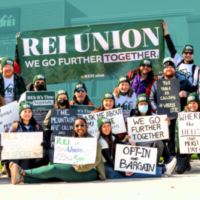Allowing Colorado’s public-sector county and local employees to join unions will improve services, reduce worker injuries, and address the employee turnover crisis in Colorado’s human services programs.
Executive Summary
Public-sector human services employees employed by counties and localities in Colorado administer critical services such as child and adult protection, job training, food assistance, Medicaid and other programs,
However, these workers but often toil under conditions that are hazardous to their own safety and health and contribute to high turnover that can disrupt service provision for their clients. In fact, our analysis shows that Colorado’s human services workers are injured on the job at double the rate of workers overall in the state. In addition, a comparison of turnover data between states shows that the turnover rate for these workers in Colorado is among the worst in the country.
-
Jobs are not safe: high rates of injury
- Public-sector human services workers have more than twice as many serious injuries (injuries serious enough to involve days away from work) as workers overall in Colorado (See Figure 1.)[1]
- The work-related serious injury rate for human service workers in Colorado is one of the highest for workers of any industry—public or private—in the state and is higher than injury rates for construction and manufacturing.[2] (See Table 1.)
-
High turnover
- More than 1 in 4 of Colorado’s human services employees leave their jobs each year (Table 2). [3]
- Colorado’s turnover rate for human services is 27.5 percent, as compared to 23.5 percent, the median rate for human services workers among all states.[4]
- Colorado has ranked in the bottom third of states for turnover for this group of public-sector workers in every year except one since 2010 (Table 2).[5]
- Most human services workers in Colorado are female (66.7 percent) and the turnover rate among female workers (27.5 percent) is about five percentage points higher than the rate among male workers (22.8 percent).[6]
Compounding these problems is the fact that many Colorado public-sector employees—unlike public employees in most U.S. states—lack the basic freedom to come together to negotiate about their workplace conditions through a union. In addition, unlike private sector workers, Colorado human service workers are not covered by the Occupational Safety and Health Administration (OSHA), and therefore have no OSHA protections regarding basic workplace safety and health standards—making union representation even more important. Without a meaningful avenue to speak up about poor and dangerous job conditions, many have no recourse but to leave their jobs—destabilizing services and driving up costs for counties and localities. Allowing these valued public servants to have democratic representation on the job will result in safer workplaces and greater job satisfaction and is crucial to ensuring a high quality of services for Coloradans who depend on them.
Download the publication to read more.
Endnotes
[1] Colorado Department of Labor and Employment (CDLE), Division of Worker Compensation. (2017). Work-Related Injuries – Table 10 Distribution of Lost-Time Claims, and Rate of Lost-Time Claims, by North American Industry Classification System (NAICS) Sub-Sector, Date of Injury, 2004-2017. https://www.colorado.gov/pacific/cdle/node/20326 Data were provided to NELP upon request.
[2] Colorado Department of Labor and Employment, Division of Worker Compensation.
[3] NELP analysis of Quarterly Workforce Indicators (QWI) 2010-2017, U.S. Census Bureau. Note: QWI groups state and local employees together in public sector industries..
[4] Excluding South Dakota and Washington, D.C. for which data were unavailable.
[5] NELP analysis of QWI.
[6] NELP analysis of QWI.




